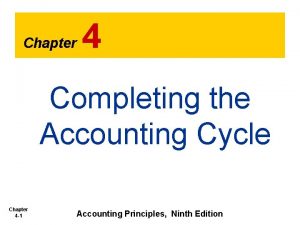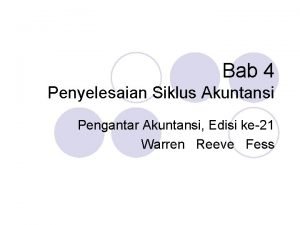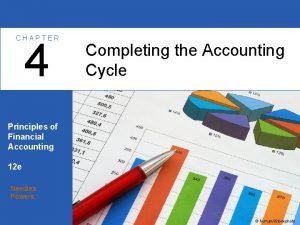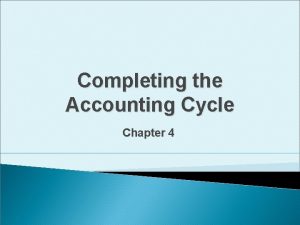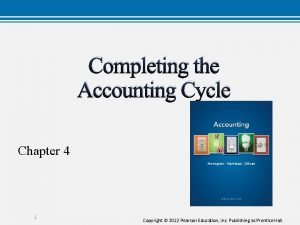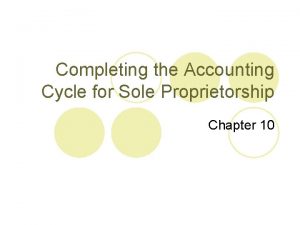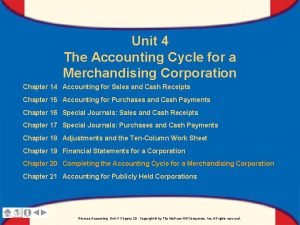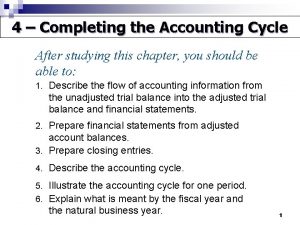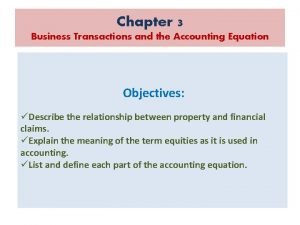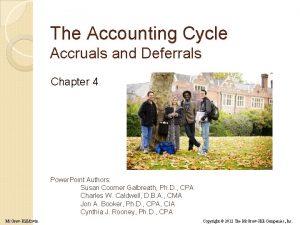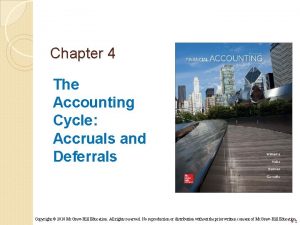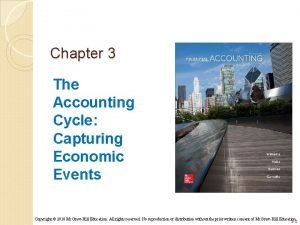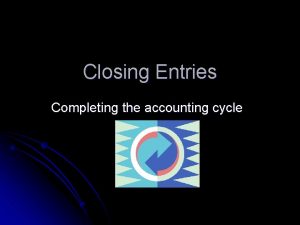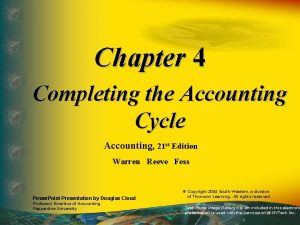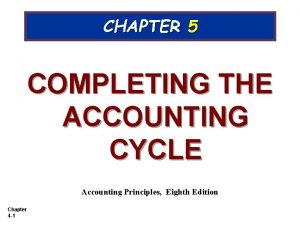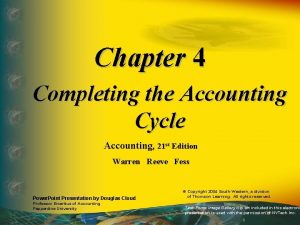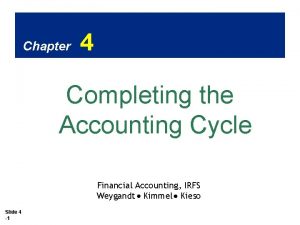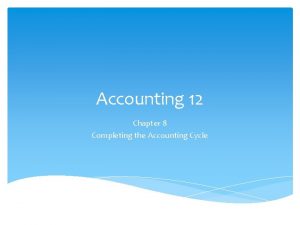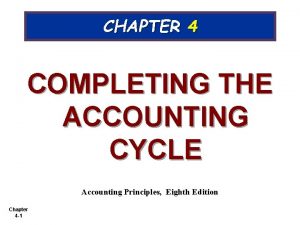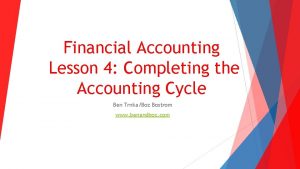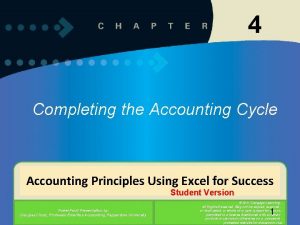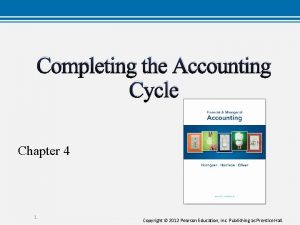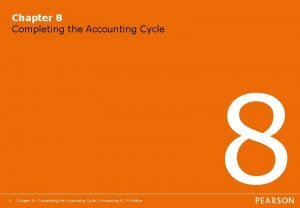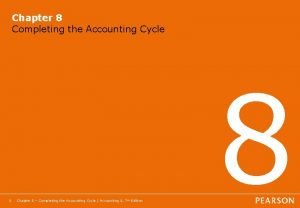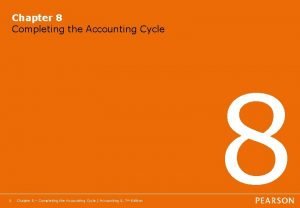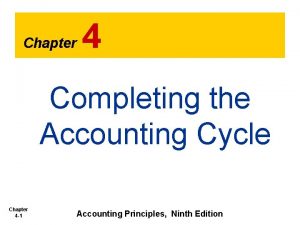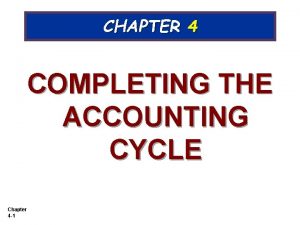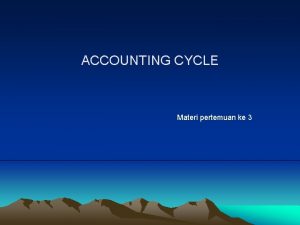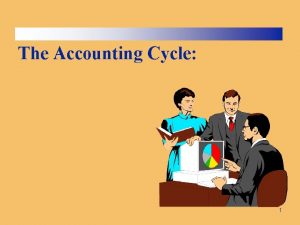Completing the Accounting Cycle Chapter 4 1 Copyright
























































- Slides: 56

Completing the Accounting Cycle Chapter 4 1 Copyright © 2012 Pearson Education, Inc. Publishing as Prentice Hall.

Learning Objectives Prepare an accounting worksheet Use the worksheet to prepare financial statements Close the revenue, expense, and dividend accounts Prepare the post-closing trial balance 2 Copyright © 2012 Pearson Education, Inc. Publishing as Prentice Hall.

Learning Objectives Classify assets and liabilities as current or long-term Describe the effect of various transactions on the current ratio and the debt ratio Understand reversing entries (see Appendix 4 A, located at myaccountinglab. com) 3 Copyright © 2012 Pearson Education, Inc. Publishing as Prentice Hall.

The Accounting Cycle Process used to produce financial statements A worksheet summarizes needed data Cycle begins with Assets = Liabilities + Equity and revenues and expenses set equal zero Accounting occurs: During the period At the end of the period 4 Copyright © 2012 Pearson Education, Inc. Publishing as Prentice Hall.

Accounting Cycle Journalize Transaction During the period Post to Accounts Adjust Accounts At the end of the period Prepare Financial Statements Close Accounts 5 Copyright © 2012 Pearson Education, Inc. Publishing as Prentice Hall.

Steps in the Accounting Cycle Start with the beginning account balances. Analyze and journalize transactions as they occur. Prepare the post-closing trial balance. Journalize and post the closing entries. Post to the accounts. Prepare the financial statements. Compute the unadjusted balance in each account. Enter the trial balance and complete the worksheet. Journalize and post adjusting entries 6 Copyright © 2012 Pearson Education, Inc. Publishing as Prentice Hall.

1 Prepare an accounting worksheet 7 Copyright © 2012 Pearson Education, Inc. Publishing as Prentice Hall.

Worksheet A tool used to summarize information NOT: A journal A ledger A financial statement Computerized spreadsheets work well Contains heading similar to statements 8 Copyright © 2012 Pearson Education, Inc. Publishing as Prentice Hall.

Worksheet Step 1 Enter account titles unadjusted balances Total the amounts 9 Copyright © 2012 Pearson Education, Inc. Publishing as Prentice Hall.

Worksheet Step 2 Enter the adjusting entries Total the amounts 10 Copyright © 2012 Pearson Education, Inc. Publishing as Prentice Hall.

Worksheet Step 3 $2, 200 (Dr) + $400 (Dr) = $2, 600 $600 (Cr) - $200 (Dr) = $400 Compute account’s adjusted balance Enter the adjusted balance in the Adjusted trial balance column 11 Copyright © 2012 Pearson Education, Inc. Publishing as Prentice Hall.

Worksheet Step 4 Draw an imaginary line above the revenue account Accounts above the line are Balance sheet accounts Accounts below the line are Income Statement accounts 12 Assets Liabilities Equity Revenue Expenses Copyright © 2012 Pearson Education, Inc. Publishing as Prentice Hall.

Worksheet Step 5 Using the income statement columns, compute net income Revenues minus expenses Enter net income as the balancing amount Revenues total = $7, 600 Expenses total = $3, 900 Net Income = $3, 700 13 Copyright © 2012 Pearson Education, Inc. Publishing as Prentice Hall.

Worksheet Step 5 Also enter net income as a balancing amount in the balance sheet columns Net income from previous columns 14 Copyright © 2012 Pearson Education, Inc. Publishing as Prentice Hall.

Data for the unadjusted trial balance of Mexican Riviera Tanning Salon at March 31, 2012, follow. Adjusting data for March 2012 are: a. Accrued service revenue, $2, 600. c. Accrued salary expense, $1, 700. b. Supplies used in operations, $400. d. Depreciation expense, $4, 100. Les Neeland, the principal stockholder, has received an offer to sell the company. He needs to know the net income for the month covered by these data. 1. Prepare the worksheet for Mexican Riviera Tanning Salon. 2. How much was the net income/net loss for March? 15 Copyright © 2012 Pearson Education, Inc. Publishing as Prentice Hall.

ADJUSTED INCOME BALANCE TRIAL BALANCE STATEMENT SHEET DEBIT CREDIT ACCOUNT TITLE Cash Accounts receivable Supplies Equipment Accumulated depreciation Accounts payable Salary payable Neeland, capital Service revenue Salary expense Depreciation expense Supplies expense Net income 16 13, 000 2, 600 1, 000 66, 500 43, 900 4, 100 400 131, 500 22, 600 3, 200 1, 700 11, 500 92, 500 43, 900 4, 100 400 131, 500 48, 400 92, 500 44, 100 92, 500 13, 000 2, 600 1, 000 66, 500 22, 600 3, 200 1, 700 11, 500 83, 100 39, 000 44, 100 83, 100 Copyright © 2012 Pearson Education, Inc. Publishing as Prentice Hall.

2 Use the worksheet to prepare financial statements 17 Copyright © 2012 Pearson Education, Inc. Publishing as Prentice Hall.

Preparing Financial Statements from a Worksheet The worksheet contains the financial statement data. Income statement column equals the income statement The Net income total is for our statement of owner’s equity Connects the Net income to the balance sheet Balance sheet column equals the balance sheet Worksheet is an internal document Financial statements are for external users 18 Copyright © 2012 Pearson Education, Inc. Publishing as Prentice Hall.

Worksheet Compare the balances here with the Income Statement appearing next. Income Statement 19 Copyright © 2012 Pearson Education, Inc. Publishing as Prentice Hall.

Preparing Financial Statements Beginning capital is found in the balance sheet columns, along with Drawing Net income is found in the income statement columns Ending capital is computed here Carry the ending Capital balance to the balance sheet 20 Copyright © 2012 Pearson Education, Inc. Publishing as Prentice Hall.

Worksheet Balance Sheet Compare the balances on the worksheet with the Balance Sheet appearing next. 21 Copyright © 2012 Pearson Education, Inc. Publishing as Prentice Hall.

Adjusting entries are prepared after the worksheet is completed. 22 Copyright © 2012 Pearson Education, Inc. Publishing as Prentice Hall.

Journalizing and Posting the Adjusting Entries Worksheet allows small businesses to see results without posting adjusting entries Many business adjust at end of year only Financial statements can be prepared without adjusting accounts Adjusting information is found on the worksheet 23 Copyright © 2012 Pearson Education, Inc. Publishing as Prentice Hall.

3 Close the revenue, expense, and dividend accounts 24 Copyright © 2012 Pearson Education, Inc. Publishing as Prentice Hall.

Closing the Accounts Occurs at the end of the period Gets accounts ready for next period Zeroes out revenue and expense accounts Updates Capital to the ending balance Four step process Close temporary accounts 25 Copyright © 2012 Pearson Education, Inc. Publishing as Prentice Hall.

Temporary and Permanent Accounts Temporary Permanent Closed at the end of the Not closed at the end of period the period Revenues Expenses Drawing Start next period with a zero balance 26 Assets Liabilities Capital Ending balance carries forward to next period Copyright © 2012 Pearson Education, Inc. Publishing as Prentice Hall.

Closing the Accounts Step 1 – Close Revenues to Income summary account Step 2 – Close individual Expense accounts to Income summary account Step 3 – Close Income summary account to Capital account Step 4 - Close Drawings account to Capital account 27 Copyright © 2012 Pearson Education, Inc. Publishing as Prentice Hall.

Four Closing Entries 28 Copyright © 2012 Pearson Education, Inc. Publishing as Prentice Hall.

The adjusted trial balance from the January worksheet of Silver Sign Company is shown: 1. Journalize Silver’s closing entries at January 31. 29 Copyright © 2012 Pearson Education, Inc. Publishing as Prentice Hall.

1. Journalize Silver’s closing entries at January 31. Jan. 31 Service revenue Income summary 31 Income summary Salary expense Rent expense Depreciation expense Supplies expense Utilities expense 30 $16, 800 6, 200 3, 600 1, 400 200 600 Copyright © 2012 Pearson Education, Inc. Publishing as Prentice Hall.

31 Income summary Silver, capital 31 Silver, capital Silver, drawing 10, 600 800 2. How much net income or net loss did Silver earn for January? How can you tell? Silver had net income of $10, 600. We know this because service revenue exceeded total expenses. 31 Copyright © 2012 Pearson Education, Inc. Publishing as Prentice Hall.

4 Prepare post-closing trial balance 32 Copyright © 2012 Pearson Education, Inc. Publishing as Prentice Hall.

Post-Closing Trial Balance List of permanent accounts and their balances after posting closing entries Total debits and credits must be equal Same accounts as on the balance sheet 33 Copyright © 2012 Pearson Education, Inc. Publishing as Prentice Hall.

After closing its accounts at July 31, 2012, Goodrow Electric Company had the following account balances: 1. Prepare Goodrow’s post-closing trial balance at July 31, 2012. 34 Copyright © 2012 Pearson Education, Inc. Publishing as Prentice Hall.

Goodrow Electric Company Post-Closing Trial Balance July 31, 2012 Cash $ 100 Accounts receivable 1, 600 Supplies 200 Equipment 4, 500 Accumulated depreciation $ 1, 300 Land 1, 200 Accounts payable 1, 100 Unearned service revenue 1, 400 Long-term liabilities 800 Goodrow, capital 3, 000 Total $ 7, 600 35 Copyright © 2012 Pearson Education, Inc. Publishing as Prentice Hall.

5 Classify assets and liabilities as current or long-term 36 Copyright © 2012 Pearson Education, Inc. Publishing as Prentice Hall.

Liquidity Measures quickness of cash How quickly an item can be converted into cash Classified Balance Sheet Lists assets in order of their liquidity Current Assets Converted to cash, sold, or used Within one year or operating cycle 37 Copyright © 2012 Pearson Education, Inc. Publishing as Prentice Hall.

Operating Cycle Cash used to buy goods & services Business collects cash from customers 38 Goods & services sold to customers Copyright © 2012 Pearson Education, Inc. Publishing as Prentice Hall.

Current Assets Examples: Cash Accounts receivable Supplies Prepaid expenses Inventory 39 Copyright © 2012 Pearson Education, Inc. Publishing as Prentice Hall.

Long-Term Assets Not converted to cash within the current year or operating cycle Categories Plant assets Land Building Furniture Equipment Long-term investments Other assets 40 Copyright © 2012 Pearson Education, Inc. Publishing as Prentice Hall.

Current Liabilities Must be paid either with cash or goods and services within one year or operating cycle Examples: Accounts payable Notes payable due within one year Salary payable Interest payable Unearned revenue 41 Copyright © 2012 Pearson Education, Inc. Publishing as Prentice Hall.

Long-Term Liabilities Are not due within the current year or operating cycle Examples: Notes payable with due dates over one year Mortgages 42 Copyright © 2012 Pearson Education, Inc. Publishing as Prentice Hall.

Classified Balance Sheet: Account Form 43 Copyright © 2012 Pearson Education, Inc. Publishing as Prentice Hall.

Classified Balance Sheet Report Form 44 Copyright © 2012 Pearson Education, Inc. Publishing as Prentice Hall.

Account Buildings Accounts payable Total expenses Accumulated depreciation Accrued liabilities (Salary payable) Prepaid expenses Service revenue Cash Receivables Interest expense Equipment Identification Classification Assets Liabilities Neither Assets Long-term Current N/A Long-term Liabilities Current Assets Neither Assets Current N/A Long-term 1. Identify the assets (including contra assets) and liabilities 2. Classify each asset and each liability as current or long-term 45 Copyright © 2012 Pearson Education, Inc. Publishing as Prentice Hall.

6 Use the current ratio and the debt ratio to evaluate a company 46 Copyright © 2012 Pearson Education, Inc. Publishing as Prentice Hall.

Accounting Ratios To measure the business’s financial position Decision makers use financial ratios Two widely used ratios: Current ratio Debt ratio 47 Copyright © 2012 Pearson Education, Inc. Publishing as Prentice Hall.

Current Ratio Measures a company’s ability to pay its current liabilities Rule of thumb Strong current ratio is 1. 5 Current assets Current liabilities 48 Copyright © 2012 Pearson Education, Inc. Publishing as Prentice Hall.

Debt Ratio Indicates the proportion of a business’s assets that are financed with debt Measures business’s ability to pay its debts Rule of thumb: Below 60% is considered safe Total liabilities Total assets 49 Copyright © 2012 Pearson Education, Inc. Publishing as Prentice Hall.

Heart of Texas Telecom has these account balances at December 31, 2012: Note payable, long-term $ 7, 800 Accounts payable $ 3, 700 Prepaid rent 2, 300 Accounts receivable 5, 700 Salary payable 3, 000 Cash 3, 500 Service revenue 29, 400 Depreciation expense 6, 000 Supplies 500 Equipment 15, 000 1. Compute Heart of Texas Telecom’s current ratio and debt ratio. Total current assets = Total current liabilities Total liabilities $14, 500 = = Total assets $27, 000 Current ratio = Debt ratio $12, 000 6, 700 = = 1. 79 0. 54 2. How much in current assets does Heart of Texas Telecom have for every dollar of current liabilities that it owes? Heart of Texas Telecom has $1. 79 of current assets for every dollar of current liabilities that it owes. 50 Copyright © 2012 Pearson Education, Inc. Publishing as Prentice Hall.

Chapter 4 Summary The worksheet is a tool that puts the whole accounting process in one place. Remember that debits = credits in the first three columns. Columns 4 and 5 (income statement and balance sheet) debits do not equal credits until you post the net income or net loss for the period. The formal financial statements yield the same net income or loss that is shown on the worksheet. 51 Copyright © 2012 Pearson Education, Inc. Publishing as Prentice Hall.

Chapter 4 Summary Closing the accounts is just like starting a new baseball game. The score is 0 -0. All temporary account balances are zero after closing. The post-closing trial balance contains the same accounts that the balance sheet contains— assets, liabilities, Common stock, and Retained earnings. 52 Copyright © 2012 Pearson Education, Inc. Publishing as Prentice Hall.

Chapter 4 Summary Classification means dividing assets and liabilities between those that will last less than a year (current) and those that will last longer than a year (long-term). The classified balance sheet still represents the accounting equation and must balance (Assets = Liabilities + Equity). 53 Copyright © 2012 Pearson Education, Inc. Publishing as Prentice Hall.

Chapter 4 Summary The current ratio measures liquidity within one year by comparing current assets to current liabilities. The debt ratio measures the ability to pay liabilities in the long term by comparing all liabilities to all assets. The different ratios give different views of a company’s financial health. 54 Copyright © 2012 Pearson Education, Inc. Publishing as Prentice Hall.

55 Copyright © 2012 Pearson Education, Inc. Publishing as Prentice Hall.

Copyright All rights reserved. No part of this publication may be reproduced, stored in a retrieval system, or transmitted, in any form or by any means, electronic, mechanical, photocopying, recording, or otherwise, without the prior written permission of the publisher. Printed in the United States of America. 56 Copyright © 2012 Pearson Education, Inc. Publishing as Prentice Hall.
 Chapter 4 completion activity
Chapter 4 completion activity Chapter 4 completing the accounting cycle
Chapter 4 completing the accounting cycle Completing the accounting cycle chapter 4 pdf
Completing the accounting cycle chapter 4 pdf Chapter 4 completing the accounting cycle
Chapter 4 completing the accounting cycle Accounting cycle
Accounting cycle Chapter 4 completing the accounting cycle
Chapter 4 completing the accounting cycle Closing entries for sole proprietorship
Closing entries for sole proprietorship Post closing trial balance for merchandising business
Post closing trial balance for merchandising business Post closing trial balance
Post closing trial balance Problem 3-1 balancing the accounting equation
Problem 3-1 balancing the accounting equation Intermediate accounting chapter 1
Intermediate accounting chapter 1 Chapter 4 the accounting cycle accruals and deferrals
Chapter 4 the accounting cycle accruals and deferrals Chapter 4 the accounting cycle accruals and deferrals
Chapter 4 the accounting cycle accruals and deferrals Chapter 3 accounting cycle
Chapter 3 accounting cycle Accounting chapter 3
Accounting chapter 3 Chapter 5 principles of engine operation
Chapter 5 principles of engine operation 18.4 participating in a job interview
18.4 participating in a job interview Chapter 17:1 developing job-keeping skills
Chapter 17:1 developing job-keeping skills Hát kết hợp bộ gõ cơ thể
Hát kết hợp bộ gõ cơ thể Slidetodoc
Slidetodoc Bổ thể
Bổ thể Tỉ lệ cơ thể trẻ em
Tỉ lệ cơ thể trẻ em Chó sói
Chó sói Tư thế worm breton là gì
Tư thế worm breton là gì Alleluia hat len nguoi oi
Alleluia hat len nguoi oi Môn thể thao bắt đầu bằng từ đua
Môn thể thao bắt đầu bằng từ đua Thế nào là hệ số cao nhất
Thế nào là hệ số cao nhất Các châu lục và đại dương trên thế giới
Các châu lục và đại dương trên thế giới Công thức tính độ biến thiên đông lượng
Công thức tính độ biến thiên đông lượng Trời xanh đây là của chúng ta thể thơ
Trời xanh đây là của chúng ta thể thơ Cách giải mật thư tọa độ
Cách giải mật thư tọa độ Phép trừ bù
Phép trừ bù Phản ứng thế ankan
Phản ứng thế ankan Các châu lục và đại dương trên thế giới
Các châu lục và đại dương trên thế giới Thể thơ truyền thống
Thể thơ truyền thống Quá trình desamine hóa có thể tạo ra
Quá trình desamine hóa có thể tạo ra Một số thể thơ truyền thống
Một số thể thơ truyền thống Cái miệng xinh xinh thế chỉ nói điều hay thôi
Cái miệng xinh xinh thế chỉ nói điều hay thôi Vẽ hình chiếu vuông góc của vật thể sau
Vẽ hình chiếu vuông góc của vật thể sau Nguyên nhân của sự mỏi cơ sinh 8
Nguyên nhân của sự mỏi cơ sinh 8 đặc điểm cơ thể của người tối cổ
đặc điểm cơ thể của người tối cổ Ví dụ về giọng cùng tên
Ví dụ về giọng cùng tên Vẽ hình chiếu đứng bằng cạnh của vật thể
Vẽ hình chiếu đứng bằng cạnh của vật thể Vẽ hình chiếu vuông góc của vật thể sau
Vẽ hình chiếu vuông góc của vật thể sau Thẻ vin
Thẻ vin đại từ thay thế
đại từ thay thế điện thế nghỉ
điện thế nghỉ Tư thế ngồi viết
Tư thế ngồi viết Diễn thế sinh thái là
Diễn thế sinh thái là Dot
Dot Số.nguyên tố
Số.nguyên tố Tư thế ngồi viết
Tư thế ngồi viết Lời thề hippocrates
Lời thề hippocrates Thiếu nhi thế giới liên hoan
Thiếu nhi thế giới liên hoan ưu thế lai là gì
ưu thế lai là gì Sự nuôi và dạy con của hổ
Sự nuôi và dạy con của hổ Sự nuôi và dạy con của hổ
Sự nuôi và dạy con của hổ

